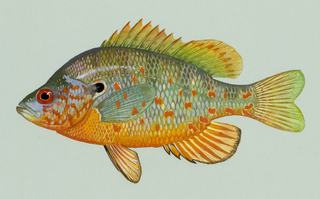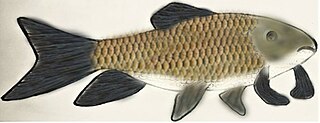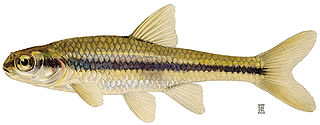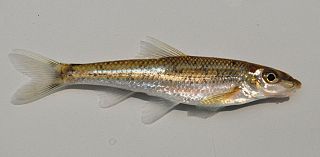
The warmouth is a freshwater fish of the sunfish family (Centrarchidae) that is found throughout the eastern United States. Other local names include molly, redeye, goggle-eye, red-eyed bream, and strawberry perch.

The longnose sucker is a species of cypriniform freshwater fish in the family Catostomidae. It is native to North America from the northern United States to the top of the continent. It is also found in Russia in rivers of eastern Siberia, and this one of only two species of sucker native to Asia.

The orangespotted sunfish is a North American species of freshwater fish in the sunfish family (Centrarchidae) of order Perciformes. These fish are widely distributed across the middle and eastern United States, from the Rocky Mountains to the east, from the Great Lakes south into the Gulf Coast. The orangespotted sunfish is ecologically unique and thrives in turbid, shallow systems that have few predators and low oxygen contents. The species prefers vegetated areas in sluggish backwaters or lakes, and can also be found in turbid rivers. The orangespotted sunfish can extend its range in lower-quality waters, which is not characteristic to other sunfish. Orangespotted sunfish vary in total length and age for different river basin originations, but can be found to live four to seven years, and recorded lengths are up to 15 cm (5.9 in).

The golden redhorse is a species of freshwater fish endemic to Ontario and Manitoba in Canada and the Midwestern, southern, and eastern United States. It lives in calm, often silty or sandy waters in streams, small to large rivers, and lakes.

The greater redhorse is a species of freshwater fish found in northeastern North America. It is the largest member of the genus Moxostoma, with a maximum length of 80 cm (31.5 in). The greater redhorse is long lived with a maximum reported age of 27 years.

The river redhorse is a species of freshwater fish endemic to the eastern half of the United States and southeastern Canada. They can range from 10 to 30 inches in length and can potentially reach a weight of more than 10 pounds after maturity. It is typically found in clear, large creeks and rivers, though it is sometimes also found in lakes. They are sometimes speared or caught with hook and line using crayfish or worms as bait.

The shorthead redhorse is a wide-ranging species in North America. The shorthead redhorse is native to central and eastern North America. However, its range has expanded to include areas like the Hudson estuary and Grayson County, Texas. It inhabits small to large rivers and lakes, and lives in the benthic zone. Shorthead redhorse feed on benthic invertebrates and can consume plant material from the benthic environment that it inhabits. When it spawns, shorthead redhorse move into more shallow streams and spawn over gravel or rocky shoals. They will also spawn in springs with swift moving water. The shorthead redhorse is important to humans because it is a game fish. It is also important to anglers because of its role in the ecosystem; it is prey for larger game fish such as northern pike and muskellunge.

The silver redhorse is a species of freshwater fish endemic to Canada and the United States. It is the longest-lived redhorse known, with a maximum reported age of 41 years. Sometimes called redhorse or sucker for short, it is in the family Catostomidae with other suckers. The species is distributed from Quebec to Alberta and is also in the Mississippi River, St. Lawrence River, Ohio River, and the Great Lakes basins. The current world record is 14 pounds, 14 ounces, caught by Chris Stephenson on Pickwick Lake in Alabama, April 1995 and certified by National Freshwater Fishing Hall of Fame. This species is of growing interest to rod-and-line anglers. The long-lived and late-maturing silver redhorse is also a sportfish pursued by kill-and-dump bowfishing, a 21st century unregulated sport that produces tons of wanton waste, and thus management and conservation are in need of updating.

The longnose dace is a freshwater minnow native to North America. Rhinicthys means snout fish and cataractae means of the cataract. Longnose dace are small, typically less than 100 mm and characterized by their fleshy snout that protrudes past the mouth. They are well adapted for living on the bottom of fast-flowing streams among stones. Longnose dace eat algae and aquatic insects and are important forage minnows for larger predatory fish.

Moxostoma, the redhorses or jumprocks, is a genus of North American ray-finned fish in the family Catostomidae. Redhorses are variable in size, geographic location, and other ecological traits such as spawning substrate. Several redhorses are long-lived, much like many other catostomid species. The silver redhorse is the longest-lived redhorse known by nearly a decade, with ages exceeding 40 years. Redhorses are broadly of conservation concern, as these long-lived species are highly intolerant to environmental pollution, habitat fragmentation, and are currently subject to unregulated 21st century sport bowfishing which is removing and wantonly wasting several of these species by the ton.

The copper redhorse is a North American species of freshwater fish in the family Catostomidae. It is found only in Canada.

The harelip sucker was a species of ray-finned fish in the family Catostomidae. It was found only in the United States. It is considered extinct as it has not been seen alive since 1893.

The bridle shiner is a member of the minnow family (Cyprinidae). This species has been identified as being of Special Concern by the Committee on the Status of Endangered Wildlife in Canada (COSEWIC).

The channel darter is a species of freshwater ray-finned fish, a darter from the subfamily Etheostomatinae, part of the family Percidae, which also contains the perches, ruffes and pikeperches. It is native to North America where it typically occurs in the sandy or gravelly shallows of lakes and in small and medium-sized rivers in riffles over sand, gravel or rock bottoms. It is a small fish ranging from 34 to 72 mm in length, olive brown with darker speckles and sometimes with a dark spot below the eye and dark blotches along the flank. It feeds mostly on insect larvae and other small invertebrates and breeds in small streams. This species is listed as threatened by the Canadian Species at Risk Act (SARA) but overall it has a wide range and numerous sub-populations and the International Union for Conservation of Nature has rated it as a "least concern species".

The bigeye shiner is a species of ray-finned fish in the genus Notropis. This fish is a slender, silvery minnow with a dusky lateral stripe and a maximum total length of about 80 mm (3.1 in). Its distinct characteristic is its large-diameter eyes. It is a common species in upland streams of the middle Mississippi River system. Bigeye shiners prefer warm, quiet pools with clear water and silt-free substrates. Siltation, channelization, and gravel dredging are all threats to bigeye shiner populations. During spawning season, typically late April to August, bigeye shiners have several clutches of eggs. State agencies and the EPA have both played a role in the surveying of bigeye shiner populations. Populations have decreased in Ohio due mostly to habitat destruction. In addition to habitat destruction by humans, habitat alteration of the small streams and dried pools has also had a significant effect on abundance. Rivers and streams should not be channelized or modified in any way, which is becoming an increasingly popular trend in urban locations. Agricultural areas and properties within the watershed should adhere to regulations to prevent runoff into the streams.
The carmine shiner is a freshwater fish species. In Manitoba, it was once known as the rosyface shiner. Based mostly on zoogeographic data, it is currently classified as a distinct species within the rosyface shiner species complex. The carmine shiner is a member of the Minnow family, Cyprinidae. It has the following characteristics and distinguishing features:

The V-lip redhorse is a species of freshwater catostomid fish from Eastern North America. It inhabits drainages on the Atlantic Slope between Virginia and South Carolina.

The blacktail redhorse is a species of ray-finned fish in the genus Moxostoma. The blacktail redhorse occupies North America, being located throughout Mississippi River tributaries on the former Mississippi Embayment, ranging from Southern Kentucky to Galveston Bay in Texas.

Bigeye chub is a species of freshwater fish in the carp family (Cyprinidae).

The gravel chub, also known as the spotted chub, is a freshwater minnow from the family Cyprinidae. This species of fish has a spotted distribution inhabiting various small rivers and streams in North America. The gravel chub requires a highly specific clean habitat making it vulnerable to various types of pollutants and in need of conservation efforts.





















